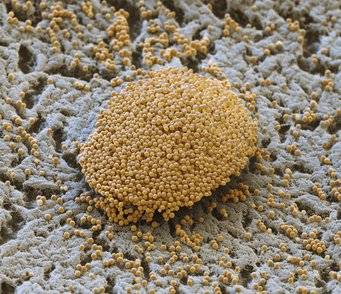
Fruiting body morphology & evolution

M. xanthus has emerged as the model organism to understand the molecular mechanisms underlying fruiting body formation in Myxobacteria. All Myxobacteria tested - with the exception of one - initiate fruiting body formation in response to starvation suggesting that the last common ancestor of the Myxobacteria harboured a genetic program for fruiting body formation and that fruiting Myxobacteria would share in common a genetic program underlying fruiting body formation.
We used comparative and functional genomics on four complete genomes of fruiting Myxobacteria (M. xanthus, S. aurantiaca, Sorangium cellulosum and Haliangium ochraceum) and one genome of the only known non-fruiting Myxobacterium (Anaeromyxobacter dehalogenans) to test this hypothesis. Surprisingly, these comparative analyses strongly indicate that the genetic programs for fruiting body formation in M. xanthus and S. aurantiaca are very similar but significantly different from the genetic program directing fruiting body formation in S. cellulosum and H. ochraceum. In other words, our analyses reveal an unexpected level of plasticity in the genetic programs for fruiting body formation in the Myxobacteria and suggest that the genetic program underlying fruiting body formation in different Myxobacteria is not conserved. The differences in these genetic programs may either reflect convergent evolution, i.e. fruiting bodies are not homologous structures, or divergent evolution, i.e. fruiting bodies are homologous structures generated from non-homologous proteins.

To follow up on these surprising findings, we are currently generating high quality, completed genome sequences of selected Myxobacteria. Moreover, we conduct comparative transcriptomics analyses to map similarities and differences between transcriptional programs in different Myxobacteria during fruiting body formation.
Some of our recent publications on fruiting body morphology & evolution:
Treuner-Lange, A., Bruckskotten, M., Rupp, O., Goesmann, A. & Søgaard-Andersen, L. (2017)
The complete genome sequence of the fruiting myxobacterium Melittangium boletus DSM 14713. Genome Announc. 5, e01262-17. doi: 10.1128/genomeA.01262-17
Treuner-Lange, A., Bruckskotten, M., Rupp, O., Goesmann, A. & Søgaard-Andersen, L. (2017)
Draft genome sequence of the fruiting myxobacterium Nannocystis exedens DSM 71. Genome Announc. 5, e01227-17. doi: 10.1128/genomeA.01227-17
Treuner-Lange, A., Bruckskotten, M., Rupp, O., Goesmann, A. & Søgaard-Andersen, L. (2017)
Whole genome sequence of the fruiting myxobacterium Cystobacter fuscus DSM 52655. Genome Announc. 5, e01196-17. doi: 10.1128/genomeA.01196-17
Treuner-Lange, A., Bruckskotten, M., Rupp, O., Goesmann, A. & Søgaard-Andersen, L. (2017)
The complete genome sequence of the fruiting myxobacterium Myxococcus macrosporus strain DSM 14697 by PacBio sequencing. Genome Announc. 5, e01127-17. doi: 10.1128/genomeA.01127-17
Claessen, D., Rozen, D.E., Kuipers, O.P., Søgaard-Andersen, L. & van Wezel, G.P (2014)
Bacterial solutions to multicellularity: A tale of biofilms, filaments and fruiting bodies. Nat. Rev. Microbiol. 2, 115-124. doi: 10.1038/nrmicro3178
Huntley, S., Kneip, S., Treuner-Lange, A. & Søgaard-Andersen, L. (2013)
Complete genome sequence of Myxococcus stipitatus strain DSM 14675, a fruiting myxobacterium. Genome Announc. 1, e00100-13. doi: 10.1128/genomeA.00100-13
Huntley, S., Wuichet, K. & Søgaard-Andersen, L. (2013)
Genome evolution and content in the myxobacteria. In “Myxobacteria: Genomics, Cellular and Molecular Biology” ed. Higgs, P.I. & Yang, Z. Horizon Press. pp. 31-50.
Huntley, S., Zhang, Y., Treuner-Lange, A., Kneip, S., Sensen, C.W. & Søgaard-Andersen, L. (2012)
Complete genome sequence of the fruiting myxobacterium Corallococcus coralloides DSM 2259. J. Bacteriol. 194, 3012-3013. doi: 10.1128/JB.00397-12
Huntley, S., Hamann, N., Wegener-Feldbrügge, S., Treuner-Lange, A., Kube, M., Reinhardt, R., Klages, S., Müller, R., Ronning, C.M., Nierman, W.C. & Søgaard-Andersen, L. (2011)
Comparative genomic analysis of fruiting body formation in Myxococcales. Mol. Biol. Evol. 28, 1083-1097. doi: 10.1093/molbev/msq292

